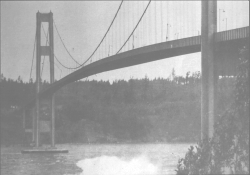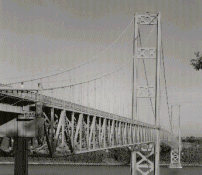 Mathematically, modeling the bridge
as a function of space and time can lead to complicated equations. The
figure to the right schematically shows the vertical deflection y(t) and
the horizontal deflection angle x(t).
Mathematically, modeling the bridge
as a function of space and time can lead to complicated equations. The
figure to the right schematically shows the vertical deflection y(t) and
the horizontal deflection angle x(t).
 Mathematically, modeling the bridge
as a function of space and time can lead to complicated equations. The
figure to the right schematically shows the vertical deflection y(t) and
the horizontal deflection angle x(t).
Mathematically, modeling the bridge
as a function of space and time can lead to complicated equations. The
figure to the right schematically shows the vertical deflection y(t) and
the horizontal deflection angle x(t).
The simplest model uses Newton's second law. The model assumes the cables supporting the road surface behave like Hooke's law springs. Then
x'' + c x' + k x = f(t)
where c>0 is the coefficient of viscous damping divided by the mass, k is the Hooke's spring constant of the cables divided by the mass, and f(t) is the acceleration of the bridge due to the wind.
The vertical displacement y(t) is also governed by a second order constant coefficient linear differential equation y''(t)+cy'(t)+(k/3)y(t)=g, where g is the acceleration due to gravity.
The equations are known to also model mass-spring-dashpot systems, a pendulum for small displacements and LRC-electrical circuits.
The project studies the effects of viscous damping and forcing; k is given and choices are made for c and f(t).
The engineers recognized that in this equation, if c were large enough, the viscous damping would prevent oscillations from growing very large. To implement this in bridges, the engineers replaced the stiffening-plate girders with web trusses in future bridges. The differences are shown in the figure below; the old bridge is on the left and the new bridge is on the right.
 |
 |